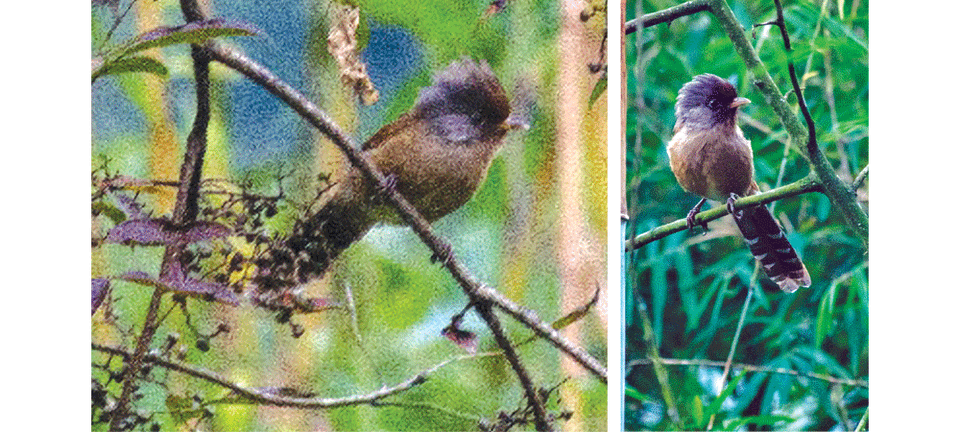- Tuesday, 30 December 2025
An Encounter With Rusty-fronted Barwig
The Annapurna Conservation Area (ACA) is one of Nepal's largest protected areas, and a biologically diverse region on Earth that overwhelms everyone with its beauty and glory. Thousands of tourists visit the conservation area annually due to its vast natural and cultural significance. According to the ACAP, tourism has been influential in the local economy, and trekking is one of the main components of the flourishing tourism industry in ACA. Thousands of lodges, hotels, and shops within 15 rural municipalities of five districts welcome more than a hundred thousand visitors per year.
Recently, a team of five students from the Environmental Science department headed towards the rising trekking spot, the Gurung and Ghale village named Sikles, along Kapuche Lake, a picturesque glacier lake at the lowest elevation (i.e., 2546 masl) through Hugu and then to little-exposed, breathtaking Kori through obscured Nohtha. Throughout the path, different species of birds and mammals, along with different flowering plants and orchids, welcomed the team delightfully.
Hugu is a small, isolated yet beautifully managed ancient settlement area lying in the bed of the Madi River. Animal husbandry and tourism are the major sources that support the local's livelihood. Bamboo, barberry (chutro), pine, rhododendron, etc. are the major vegetation types, and other shrubs are also dominant here. A variety of orchids and vibrant flowers grabbed the team's attention.
What brought the team to euphoria is the Rusty-fronted Barwing, one among the 519 bird species found in ACA. The team sighted this rare but local resident of Nepal in the Hugu region on 30th October 2021. The feeding guilds of Rufous Sibia and Rusty-fronted Barwing were observed, and more than 30 Rusty-fronted Barwing (Actinodura Egertoni) were among the flocks. Few of them settled down in the stem of barberry, feeding on its fruits and enjoying the taste with beautiful calls. Their movements from one branch to another and holding berries were magical.
Major Habitats
The Rusty-fronted Barwing is a rare but local resident of Nepal. It was observed in Eastern Nepal inside Kanchanjunga NP, Makalu Barun NP and Mai Valley Forest, in Central Nepal at Chandragiri (Makwanpur district), Phulchowki (Lalitpur district), and in Western Nepal inside Annapurna CA and Resunga Forest (Gulmi district). It is distributed along the elevation range from 1500 m to 2400 m. Chaudhary and Poudyal (2017) discarded Rusty-fronted Barwing recorded in the baseline survey of the Api Nampa area, the westernmost part of Nepal in 2012. They then proposed further detailed studies and verification in that particular area. Since Rusty-fronted Barwing is a non-migratory bird, its habitats are bound within its sighted area although no exact research has been carried out. It is a resident bird and is constricted to a much smaller zone.
The Rusty-fronted Barwing belongs to the family of Laughingthrush called Leiothrichidae. Its rufous front with a yellow bill, grey crown and pure white belly makes it unique. It is distinguished from Hoary-throated Barwing by the rusty-coloured throat and absence of a blackish terminal band. It is found in pairs or in small flocks foraging around. Sometimes, it is found mixed in the flocks of other birds too.
The Rusty-fronted Barwing is listed as 'Least Concern' in the global context by the IUCN Red List Category, while it is considered endangered at the national level. However, no significant conservation measures have been implemented to date. Nepal is believed to be the westernmost boundary for the Rusty-fronted Barwing (Gould, 1836) to date. The population trend appears to be decreasing, and the population size has yet to be determined.
Despite being listed as an endangered species, no specific actions have been taken for its conservation. The lack of information on threats and trade records might be the reason for its low or no priority in conservation. However, the ACA has been working on avifaunal conservation projects in its area. Due to its non-migratory nature, its habitat is limited. Deforestation, bush clearing, orchard clearing, wildfires, and human influences in the forest should be managed and controlled to maintain its integrity in nature.
Validation and verification are essential to confirm the identification of the Rusty-fronted Barwing, which can be identified either by direct observation or indirectly by their sounds. Photographs or sound recordings of their calls are the major keys to confirmation, especially for extended habitat ranges. Thus, our team was able to capture photographic evidence of Rusty-fronted Barwing in the Hugu region of Annapurna Conservation Area (ACA).
Hugu Region
In summary, the Rusty-fronted Barwing, known as Kailotalu banchahaar in Nepali, was observed in the Hugu region mixed with the flock of Rufous Sibia. This sighting provides an opportunity for research on their habitat range and preferred habitats. This bird is limited to Nepal, Bhutan, Myanmar, China, and India. Therefore, special considerations should be made as their home range is narrowing down due to habitat loss, degradation, and fragmentation of broad-leaved evergreen forests.
(The author, Timalsina, is a Master's Degree student in Environmental Science. He, along with Binaya Ghimire, Madhav Nepal, Nabaraj Pokharel, and Pashupati Adhikary, recently visited the ACA.Photos by Binaya Ghimire)















-original-thumb.jpg)

